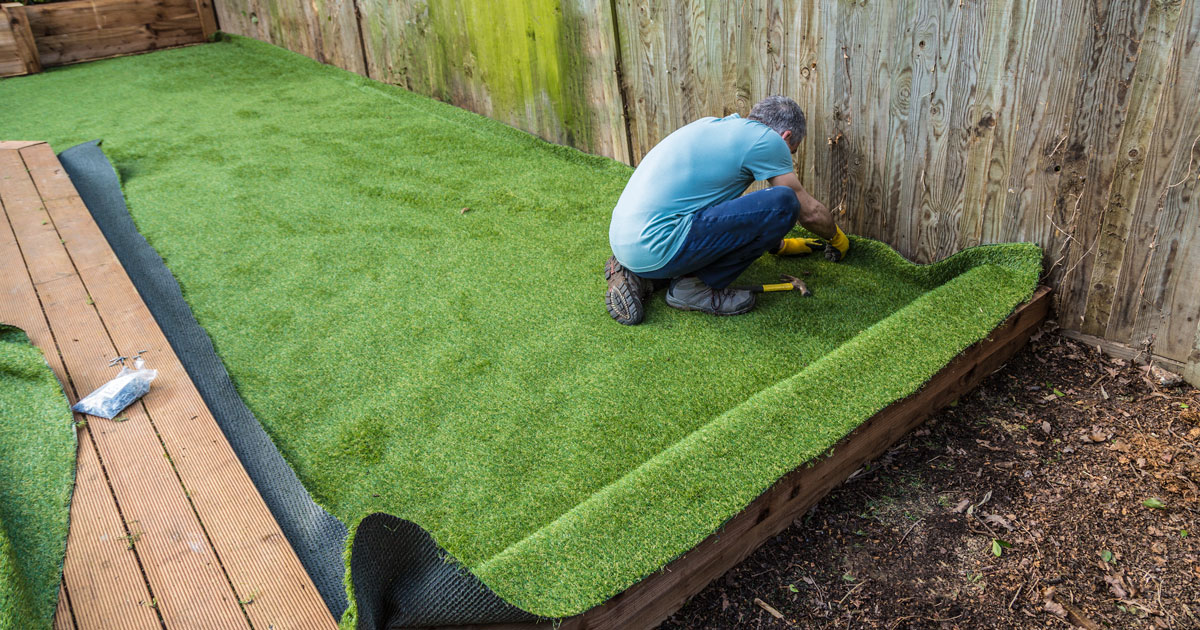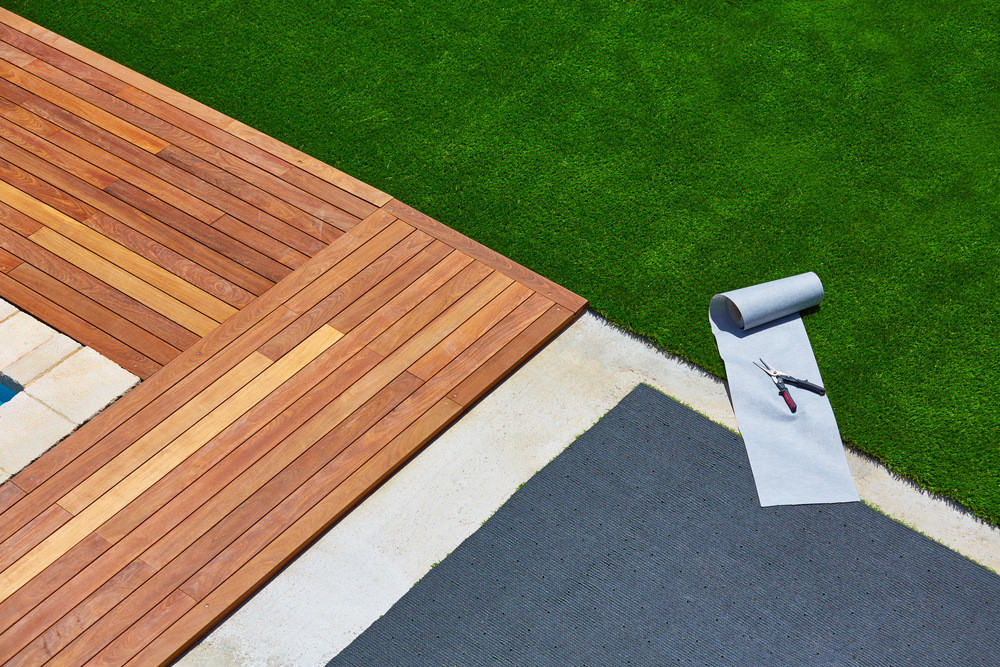Whether you’re looking to give your garden a makeover or create a lush lawn without the hassle of mowing and watering, installing artificial grass on top of decking can seem like an attractive option. But will the combination of artificial grass and wooden decking hold up over time? Let’s dig into the details. Credit: Essex Artificial Grass Artificial grass itself does not cause deck rot. With proper installation and deck maintenance, decking is unlikely to rot under an artificial grass lawn. Ensure the deck is secure, use appropriate underlay and allow for drainage to prevent moisture issues. However, existing deck rot should be repaired before installing artificial grass. – Use underlay to protect decking and allow drainage under artificial grass – Well-installed decking in good condition should not rot under artificial grass – Fix any existing deck rot issues before installing artificial grass In my experience as a landscaper, decking can successfully support an artificial grass lawn with proper installation. Proper underlay selection and allowing for drainage are critical. As long as the decking is secure and in good shape without existing rot, artificial grass should not cause any deck rot issues. Regular deck maintenance may be needed. The good news is that artificial grass does not directly cause decking to rot. Properly installed decking that has been treated to protect against the elements is unlikely to rot under an artificial lawn. The adhesives used to install artificial grass are strong and won’t damage or decompose the deck boards beneath. However, decking can be susceptible to rotting and decay over time, even without grass on top. If the deck boards already show signs of wear like cupping, splintering edges, or crumbling sections, they may not offer a stable base for artificial turf. Pre-existing moss, mould, or other moisture damage indicates the decking needs repair or replacement before installing grass. Here are some steps to minimise the chances of rotting down the line: With proper installation and care, most modern decking materials can support artificial grass for many years before signs of decay. Address any problem areas promptly to maximise the life of your deck. Credit: Artificial Lawn Several factors can contribute to decking rot over time, even without artificial grass installed on top. Being aware of these causes can help you take preventative steps. Moisture is the primary enemy of decking. Wood that is continually exposed to water or dampness will eventually start to decay. Common sources of moisture include: Sunlight and weather extremes also degrade decking. Ultraviolet rays break down the cellular structure of the wood, causing surface cracks, cupping, and splintering over time. Freezing and thawing cycles can warp and twist deck boards. Finally, normal wear and tear takes a toll. Foot traffic pounds the boards down while dragging furniture scrapes the deck surface. These stresses slowly weaken the integrity of the wood. Treating or sealing your deck provides protection against moisture, sunlight, and wear. Proper construction for drainage and airflow also helps prevent rotting. But even with the best care, most decks need replacing after 10-15 years. Installing artificial grass on top of your decking can look great, but it also traps moisture against the wood, potentially accelerating rot. With some planning and preventative steps, you can still enjoy the benefits of artificial turf without damaging your deck. Start by selecting a high-quality, permeable artificial grass designed for deck installations. Opt for a shorter pile height, which allows better airflow. Use an open weave backing that lets water drain through. Lay the turf over a porous pad or spacer mesh to elevate it off the deck surface. Allow adequate slope and drainage so water does not pool on or under the artificial grass. Aim for at least a 1-2% slope. Install deck drains or scuppers to carry away excess water. Make sure sprinklers are not spraying under the turf. Seal your deck thoroughly before installing the artificial grass, and reapply the sealant yearly. Look for water-resistant products containing UV blockers. Keep the deck surface clean and clear of debris before sealing. Improve airflow under the deck with smart design choices like sufficient ground clearance, ventilation gaps, and lattice skirting. This circulation helps prevent moisture buildup. Inspect the turf periodically for any signs of excess moisture or potential rot issues. Address any problems quickly to limit damage. With vigilant preventative care, your deck can thrive for years under artificial grass. When installing artificial grass on your deck, proper technique is key to preventing moisture issues and rot down the line. Here are some helpful installation tips: Allow at least 1-2 inches between the deck boards for drainage and airflow. If the gaps are too narrow, consider removing and re-spacing the boards. Elevate the turf off the deck surface for drainage. Use porous plastic pads, spacer meshes, or decking support systems. This drainage gap is crucial. Secure the artificial grass well at all edges and seams to avoid wind or water getting underneath. Use adhesive, turf staples, trim pieces or tape specially made for artificial turf installations. Avoid cutting or sealing around deck rails or posts. Leave gaps for airflow and drainage. Use permeable weed barrier fabric around posts if needed. At stair edges, allow some overhang for proper drainage runoff. Tuck the backing under the lip or secure it with adhesive – don’t allow the grass to flop over the edge. Inspect under the turf after heavy rains or sprinkler use. Check for standing water or excess moisture and adjust as needed. Be proactive to prevent buildup. With careful prep and installation, you can install artificial grass on your deck safely. Just be sure to allow for drainage and airflow so moisture won’t get trapped against the wood. Installing artificial grass on your deck is just the beginning. To avoid rot and other issues long-term, proper care and maintenance are essential. Periodically lift up sections of the turf to inspect the deck boards and drainage gaps underneath. Look for any signs of excess moisture or potential rot starting. An annual deep cleaning is recommended. Remove the turf, sweep and wash the deck surface, check for damage, and then replace the turf once fully dry. Adjust or replace worn turf as needed over time. Fraying edges, tears, and seam failures can allow moisture infiltration. Reapply adhesive or fasteners that pop loose or fail. Don’t allow the turf to flap freely which strains it and allows water underneath. Maintain good drainage flow by clearing debris from the gaps between deck boards and ensuring downspouts are directed away from the deck. During snowy winters, promptly remove heavy snow accumulation from the turf to avoid excessive weight and moisture buildup on the deck below. With routine inspections, maintenance, and care, your decking and artificial grass can coexist successfully for many years. Stay on top of potential trouble spots before they turn into major rot or water damage issues. Yes, it is generally fine to install artificial grass on top of the decking, as long as the deck is in good condition and can support the weight. Make sure the deck boards are secure with no protruding nails or splinters that could damage the artificial grass backing. Using an underlay is recommended for artificial grass on decking. The underlay provides a protective barrier and helps with drainage. Choose an artificial grass underlay made specifically for use on decking. On decking, use a specialised decking underlay for artificial grass. This is a porous mesh or cellular material that allows drainage. Alternatively, use a thin layer of sand. Do not use a weed membrane, as this will not drain sufficiently. Mould growth under artificial grass is rare, but possible if drainage is poor. Ensure proper drainage under the grass to prevent water pooling. Ventilation and airflow will also discourage mould growth. Artificial grass can be installed on top of the decking with good results. Proper underlay and drainage are key to preventing deck rot under artificial grass. Overall, decking should not rot from artificial grass if the deck is in good condition and proper installation methods are followed. Periodic deck maintenance may be needed.
Will Decking Rot Under Artificial Grass?

Key Points
Our Opinion
Will Decking Rot Under Artificial Grass?
Factors That Cause Decking to Rot

How to Prevent Deck Rot Under Artificial Grass
Installation Tips for Artificial Grass on Decking
Long-term Care and Maintenance Tips
FAQ
Is it OK to put artificial grass on top of decking?
Do you need underlay for artificial grass on decking?
What should you put under artificial grass?
Does mould grow under artificial grass?
Conclusion
